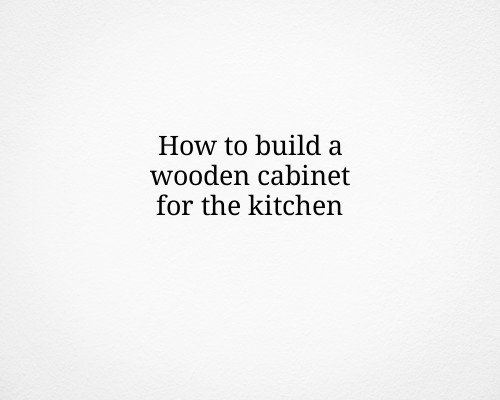Building a wooden cabinet for the kitchen can be a rewarding and functional project. Below is a step-by-step guide to help you create your own wooden kitchen cabinet:
Materials You Will Need:
- Plywood or hardwood (for cabinet frame, shelves, and doors)
- Wood screws
- Wood glue
- Hinges (for doors)
- Handles or knobs
- Cabinet feet (optional)
- Sandpaper
- Stain, paint, or wood finish
- Measuring tape
- Saw (table saw or circular saw)
- Drill
- Screwdriver
- Wood clamps
- Level
- Square
Step 1: Plan and Measure
Before starting, determine the size of the cabinet. Measure the space in your kitchen where the cabinet will go. Decide on the number of shelves and whether you will have one or more doors. Draw a rough sketch of the design, including dimensions, to help guide your project.
Step 2: Cut the Pieces
Using your saw, cut the plywood or hardwood to the required sizes for the cabinet’s sides, top, bottom, back panel, shelves, and doors. For a basic cabinet:
- Sides: Cut two pieces for the sides of the cabinet.
- Top and Bottom: Cut two pieces for the top and bottom.
- Back Panel: Cut one piece for the back.
- Shelves: Cut as many shelves as you need.
- Doors: Cut two pieces for the cabinet doors (if applicable).
Step 3: Assemble the Frame
Start by assembling the basic frame of the cabinet:
- Attach the sides to the bottom: Apply wood glue to the edges of the bottom piece, then attach it to the side pieces using screws. Use clamps to hold them in place while the glue dries.
- Attach the top: Repeat the process for attaching the top piece to the sides.
- Attach the back panel: Once the top and bottom are attached, add the back panel. Secure it with screws or nails around the edges.
Step 4: Install Shelves (Optional)
If your cabinet will have shelves, install them now. For adjustable shelves, drill holes along the inside of the cabinet sides for shelf supports. If you prefer fixed shelves, attach them permanently with wood screws.
Step 5: Prepare and Attach the Doors
- Prepare the doors: If you’re building doors, you can either use one solid piece of wood or a frame with a panel inside. Cut the doors to the desired size.
- Attach hinges: Attach hinges to one edge of each door, then secure them to the cabinet frame.
- Install the handles: Once the doors are in place, mark where the handles or knobs will go, and drill holes to attach them.
Step 6: Sand the Surface
Once the basic frame is assembled, sand all surfaces to smooth out rough edges and prepare the wood for finishing. Start with coarse-grit sandpaper and work your way to finer grit for a smooth finish.
Step 7: Finish the Cabinet
Choose a finish based on the look you desire. You can stain the wood for a natural look or paint it for a more colorful finish. Apply the stain or paint evenly, following the manufacturer’s instructions. Allow it to dry completely between coats.
Step 8: Install the Cabinet
After the cabinet is finished, it’s time to install it in your kitchen. If the cabinet is a wall-mounted unit, secure it to the wall studs using screws and a level to ensure it’s straight. For floor cabinets, you can add cabinet feet if necessary for extra support.
Step 9: Final Touches
Once installed, check that the doors open and close properly and that the shelves are sturdy. Add any additional features such as drawer slides or dividers to increase functionality.
This project can be customized to your needs, whether you’re building a simple under-counter cabinet or a larger one with multiple compartments. With the right tools, patience, and planning, you’ll have a beautiful wooden kitchen cabinet that will serve you for years.
If you’re looking for more detailed woodworking plans and step-by-step guidance, check out Teds Woodworking Course here: Teds Woodworking Course.
